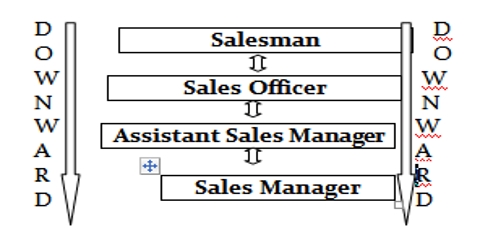Downward communication is that communication in which information flows from superior to subordinates. In the organization, people at lower levels have a high degree of fear and respect towards such communication which leads to a high degree of acceptance.
Methods of Downward Communication
Both written and oral methods are used in transmitting messages of downward communication. Actually, the selection of media depends on the nature, urgency, and importance of the message to be communicated. The followings are the frequently used media/methods of downward communication:
- Oral Media:
Downward communication is mainly done by means of oral media. It may pass directly between one person and another or group or indirectly through meetings and conferences. Usually, the supervisors give instructions to their subordinates through face-to-face and telephonic conversation. Whatever tool is used, it saves a lot of time and permits personal contact. Besides this, managers also exchange relevant information with their subordinates through meetings, conferences, lectures, etc. This fosters a friendly and co-operative spirit, ensures quick understanding and proper explanation, encourages questions and answers, and stimulates interest.
Again, it is most suitable for confidential and emergent talks. But it is not suitable if the distance between the speaker and the listener is too long. It also lacks recorded evidence and future reference and does not allow the listener much time to think, act, and react.
- Written Media:
Organization of any size and nature sends important information to its employees in written forms through letters, circulars, manuals, bulletins, posters, annual reports, etc. It means the sending of message, order or instruction in writing through a letter, circular, manual, report, telegram, office memo, bulletin, etc. Generally, letters and memos communicate important organizational directives, circulars, manuals, and bulletins communicate policies and procedures and annual report communicates organizational activities and performance at the end of the year. It is a formal method of communication and is suitable for long-distance communication and repetitive standing orders. It gives the receiver sufficient time to think, act, and react.
Moreover, it is time-consuming and expensive, and it cannot maintain secrecy, offers difficulty in explaining all matters, has no chance of clarification, is less flexible and not effective in an emergency.
- Gestural Communication:
Communication can be made through the movement of the body, facial expression, smile, modulation of voice, sign, handshake, rubbing of hands, eye-to-eye contact, style of walking, etc. As communication is made through bodily gestures it is called ‘Gestural Communication.’
Other media: In addition to oral and written media, audio, visual, and audio-visual media are also used in downward communication. Radio, television, poster, signal, symbol, graph, etc., are some of the commonly used instruments that convey messages to the subordinates.















